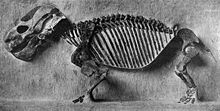
Back Endothiodon Catalan Endothiodon Spanish دروندندان Persian אנדוטיאודון HE Endothiodon Italian Endothiodon Dutch Endothiodon Russian Endothiodon Ukrainian 内齿兽属 Chinese
| Endothiodon Temporal range: Wuchiapingian,
| |
|---|---|

| |
| Reconstructed skeleton of E. bathystoma specimen AMNH 5613 | |
| Scientific classification | |
| Domain: | Eukaryota |
| Kingdom: | Animalia |
| Phylum: | Chordata |
| Clade: | Synapsida |
| Clade: | Therapsida |
| Suborder: | †Anomodontia |
| Clade: | †Dicynodontia |
| Family: | †Endothiodontidae |
| Genus: | †Endothiodon Owen, 1876 |
| Type species | |
| †Endothiodon bathystoma Owen, 1876
| |
| Other species | |
| |
| Synonyms[1] | |
|
Genus synonymy Species synonymy
| |
Endothiodon (/ɛndoʊθiːoʊdɔːn/ "inner tooth" from Greek endothi (ἔνδοθῐ), "within", and odon (ὀδών), "tooth", most likely named for the characteristic of the teeth being placed internally to the maxilla[2]) is an extinct genus of medium to large dicynodont from the Late Permian. Like other dicynodonts, Endothiodon was an herbivore, but it typically lacked the two tusks that characterized most other dicynodonts and instead had long rows of teeth inset in the jaws that replaced in waves. The anterior portion of the upper and lower jaw are curved upward, creating a distinct beak that is thought to have allowed them to be specialized grazers.[3]
Endothiodon was widespread and is found across the southern region of what was then a single large continent known as Pangea. It was originally only found in southern Africa but has now also been found in eastern Africa, India and Brazil, which were both close to Africa at the time. The finding in Brazil marks the first dicynodont to be reported for the Permian of South America.[2] This finding also shows that part of the Rio do Rasto Formation in Brazil can now be correlated with deposits in India, Malawi, Mozambique, South Africa, Tanzania, Zambia, and Zimbabwe.[2]
Historically, nine named species in total from South Africa have been attributed to Endothiodon during the late 19th and early 20th centuries (sometimes variably split into distinct genera), but these were reduced down to just three accepted species of Endothiodon in 1964. In the 21st century, these three were further thought to likely represent only a single species, the original type species E. bathystoma, a conclusion upheld by a thorough revision of their taxonomy in 2024.[4][5][6][7][1] A second valid species, E. mahalanobisi, was discovered in India and named in 2000. Although smaller than E. bathystoma, E. mahalanobisi is recognised as a distinct species rather than simply juveniles of E. bathystoma. Apart from size, E. mahalanobisi also has a pointed snout with only a single, low longitudinal ridge (compared to three raised crests on E. bathystoma), a narrow pineal foramen lacking a bony boss or collar, and a flat prefrontal bone.[1] A third species was discovered in Tanzania and named E. tolani in 2015. Unlike the other species, E. tolani has a pair of small tusks.[5] Although initially discovered in and thought to characterise separate regions, their ranges have since been found to overlap in eastern Africa, with potentially all three present in Mozambique. E. bathystoma appears to be particularly widespread, with a range from Brazil, through southern and eastern Africa and into India.[1]
- ^ a b c d Maharaj, I. E. M.; Macungo, M.; Smith, R. M. H.; Chinsamy, A.; Araújo, R. (2024). "Taxonomic revision of the late Permian dicynodont genus Endothiodon (Therapsida, Anomodontia)". Journal of Systematic Palaeontology. 22 (1). 2346578. doi:10.1080/14772019.2024.2346578.
- ^ a b c Boos, A. S.; Schultz, C. L.; Vega, C. S.; Aumond, J. J. (2013). "On the presence of the Late Permian dicynodont Endothiodon in Brazil". Palaeontology. 56 (4). doi:10.1111/pala.12020.
- ^ Latimer E. M., Gow C. E., Rubidge B. S. "Dentition and feeding niche of Endothiodon (Synapsida;Anomodontia)" Palaeontologia Africana 32, 75-82 (1995)
- ^ Cox, B. C. (1964). "On the palate, dentition, and classification of the fossil reptile Endothiodon and related genera". American Museum of Natural History (2171). hdl:2246/3347.
- ^ a b Cox, C. B.; Angielczyk, K. D. (2015). "A new endothiodont dicynodont (Therapsida, Anomodontia) from the Permian Ruhuhu Formation (Songea Group) of Tanzania and its feeding system". Journal of Vertebrate Paleontology. 35 (4). e935388. Bibcode:2015JVPal..35E5388C. doi:10.1080/02724634.2014.935388. S2CID 128730997.
- ^ Maharaj, I. E. M.; Chinsamy, A.; Smith, R. M. H. (2019). "The postcranial anatomy of Endothiodon bathystoma (Anomodontia, Therapsida)". Historical Biology: An International Journal of Paleobiology. 33 (7): 1066–1088. doi:10.1080/08912963.2019.1679128. S2CID 209607275.
- ^ Kammerer, C. F.; Ordoñez, M. D. (2021). "Dicynodonts (Therapsida: Anomodontia) of South America". Journal of South American Earth Sciences. 108: 103171. Bibcode:2021JSAES.10803171K. doi:10.1016/j.jsames.2021.103171. S2CID 233565963.